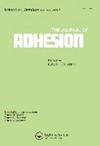Numerical analysis of the effect of ice-metal interface stress singularity on bonding failure
IF 2.3
4区 材料科学
Q2 ENGINEERING, CHEMICAL
引用次数: 0
Abstract
ABSTRACTThe formation of ice on the surface of the metallic casing of high-end equipment poses a potential threat to its operational safety and stability. One important factor that contributes to bonding failure at the ice-metal interface is stress concentration. This paper aims to investigate the effect of stress concentration on the bonding failure behavior at the ice-metal interface through numerical analysis. First, the forms of bonding failure are categorized. Afterwards, the stress distribution state at the corners of the ice-metal interface is determined by the interfacial stress singularity. Finally, numerical analysis is carried out to investigate the thermal stress distribution law at the corners of the interface during the cooling process of the ice-metal bonding, so as to elucidate the induced mechanism of the interfacial stress state on the bonding failure. This study can provide some reference and guidelines for the study of bonding failure at the ice-metal interface.KEYWORDS: Ice-metal interfacebonding failurenumerical analysisstress concentration AcknowledgmentsThe authors gratefully acknowledge the financial support from the National Natural Science Foundation of China(No. U20B2033).Disclosure statementNo potential conflict of interest was reported by the author(s).Data availability statementThe authors attest that all data for this study are included in the paper.Correction StatementThis article has been republished with minor changes. These changes do not impact the academic content of the article.Additional informationFundingThe work was supported by the National Natural Science Foundation of China [U20B2033].冰-金属界面应力奇异性对粘结破坏影响的数值分析
摘要高端装备金属机壳表面结冰对其运行的安全性和稳定性构成潜在威胁。导致冰-金属界面粘结破坏的一个重要因素是应力集中。本文旨在通过数值分析研究应力集中对冰-金属界面粘结破坏行为的影响。首先,对粘结破坏的形式进行了分类。然后,界面应力奇异性决定了冰-金属界面边角处的应力分布状态。最后,通过数值分析研究了冰-金属结合冷却过程中界面边角处的热应力分布规律,阐明界面应力状态对冰-金属结合破坏的诱导机制。该研究可为冰-金属界面粘结破坏的研究提供一定的参考和指导。关键词:冰-金属界面结合破坏;数值分析;应力集中;U20B2033)。披露声明作者未报告潜在的利益冲突。数据可用性声明作者保证本研究的所有数据均包含在论文中。更正声明这篇文章经过细微修改后重新发表。这些变化不影响文章的学术内容。本研究得到国家自然科学基金资助[U20B2033]。
本文章由计算机程序翻译,如有差异,请以英文原文为准。
求助全文
约1分钟内获得全文
求助全文
来源期刊

Journal of Adhesion
工程技术-材料科学:综合
CiteScore
5.30
自引率
9.10%
发文量
55
审稿时长
1 months
期刊介绍:
The Journal of Adhesion is dedicated to perpetuating understanding of the phenomenon of adhesion and its practical applications. The art of adhesion is maturing into a science that requires a broad, coordinated interdisciplinary effort to help illuminate its complex nature and numerous manifestations.
 求助内容:
求助内容: 应助结果提醒方式:
应助结果提醒方式:


